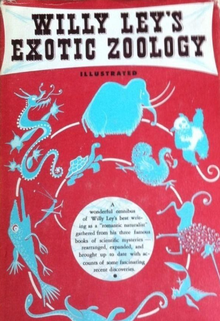 | |
| Author | Willy Ley |
|---|---|
| Illustrator | Olga Ley |
| Publisher | Random House |
Publication date | 1959 |
| ISBN | 0-517-62545-8 |
| LC Class | 59-8356 |
Exotic Zoology is a 1959 cryptozoological book[1] by Willy Ley, a science writer and space advocate. The illustrator of the book is Olga Ley.[2]
Content
[edit]Ley had written a number of books containing scientific oddities; Exotic Zoology collects the cryptozoological matter from those books.[3] Throughout the book he shows examples of organisms that were rumored to exist, or were thought to be impossible, that were shown to be real; and others that were accepted as fact, that were discovered to have never existed: "He speculates about dragons and sea serpents, wingless birds and Abominable Snowmen."[4] The book, in its description of (fictional) peoples and creatures, has been compared to John Mandeville's Travels.[5] Some of the claims have been criticized or ridiculed, for instance the statement that giant squids had left scars on whales of two feet in diameter.[6][7]
Exotic Zoology was not reviewed in many academic journals. An exception was a review in the Science journal, in 1959.[8]
References
[edit]- ^ Stein, Gordon (1996). The Encyclopedia of the Paranormal. Prometheus Books. p. 200. ISBN 978-1-57392-021-6.
- ^ "Who illustrated "Exotic Zoology"?". literature.stackexchange.com. Retrieved 2017-08-15.
- ^ Bille, Matthew A. (2006). Shadows of existence: discoveries and speculations in zoology. Hancock House. p. 216. ISBN 978-0-88839-612-9.
- ^ "Rev. of Exotic Zoology". Saturday Review. 50: 41. 1967. Retrieved 1 February 2011.
- ^ Preece, Rod (1999). Animals and nature: cultural myths, cultural realities. UBC Press. p. 277. ISBN 978-0-7748-0724-1.
- ^ Ellis, Richard (2006). Monsters of the Sea. Globe Pequot. p. 252. ISBN 978-1-59228-967-7.
- ^ Ellis, Richard (1999). The search for the giant squid. Penguin. p. 142. ISBN 978-0-14-028676-2.
- ^ Gardner, Thomas S. (1959). "Reviewed Work: Exotic Zoology by Willy Ley". Science. 130 (3387): 1469. doi:10.1126/science.130.3387.1469.a. S2CID 239833451.
External links
[edit]- A Bibliography of the Works of Willy Ley Archived 2011-08-20 at the Wayback Machine by Jean M. Perreault, University of Alabama in Huntsville
Well, that’s interesting to know that Psilotum nudum are known as whisk ferns. Psilotum nudum is the commoner species of the two. While the P. flaccidum is a rare species and is found in the tropical islands. Both the species are usually epiphytic in habit and grow upon tree ferns. These species may also be terrestrial and grow in humus or in the crevices of the rocks.
View the detailed Guide of Psilotum nudum: Detailed Study Of Psilotum Nudum (Whisk Fern), Classification, Anatomy, Reproduction